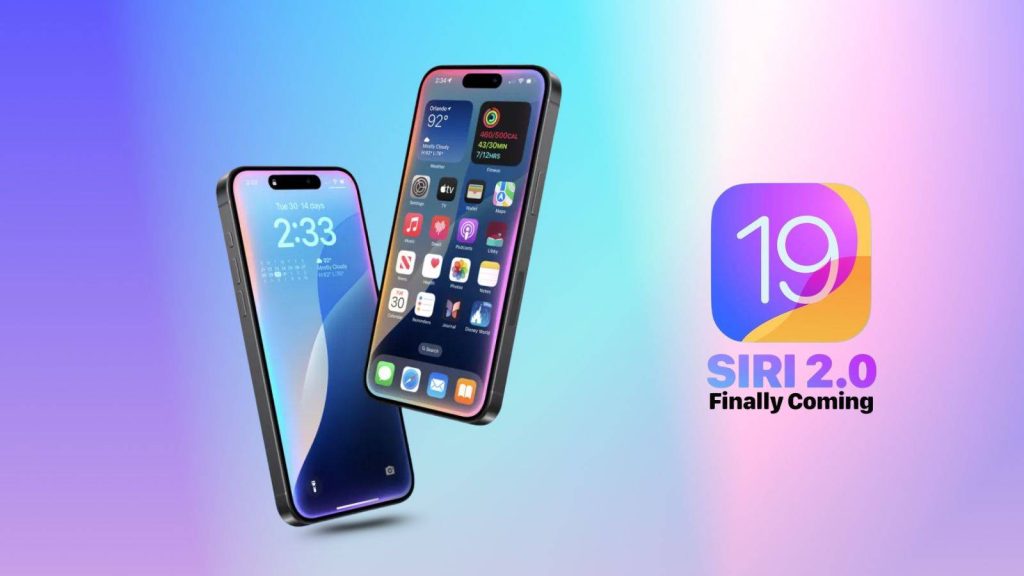Apple’s next evolution in artificial intelligence has arrived in the form of Siri 2.0 on iPhone—a completely redesigned version of Apple’s voice assistant. Since its debut in 2011, Siri has evolved steadily but never quite reached the fluid intelligence level of modern AI tools like ChatGPT or Gemini. Now, that’s changing.
With the introduction of Apple Intelligence, Siri is becoming a genuine smart assistant—one that understands context, responds naturally, and even assists within apps. The upgrade promises to transform how users interact with their iPhones by blending AI-driven intelligence with Apple’s signature focus on privacy and performance.
As advanced as Siri 2.0 is, there are also clear boundaries around what it can’t do—at least for now. Know both sides in detail.
What We Know So Far: Timeline, Availability & Support
Release Schedule and Version Expectations
According to Apple insiders, Siri 2.0 will officially debut with iOS 19 in mid-2025, first on select iPhone models. The rollout will be staged, meaning early adopters will get access to limited features before the full integration arrives later that year. Apple’s approach focuses on testing real-world performance before enabling advanced capabilities like generative AI and full app control.
Can Siri 2.0 Catch Up to ChatGPT? Here’s What’s Holding Apple Back
Siri 2.0’s public beta is expected to begin shortly after WWDC 2025, allowing developers to explore its new APIs and voice interaction features.
Device and OS Support
Upgraded Siri 2.0 on iPhone depends heavily on Apple’s A17 Pro or newer chips, which include the Neural Engine needed for on-device AI tasks. Therefore, the assistant will likely be exclusive to:
- iPhone 15 Pro and 15 Pro Max
- iPhone 16 series (all models)
- Newer iPads and Macs running Apple Silicon
Older models like the iPhone 14 or below might receive visual changes or limited AI enhancements but won’t support the full Apple Intelligence suite due to hardware limitations.
Why the Delay?
Apple delayed Siri 2.0 primarily to ensure data privacy, language accuracy, and system stability. The company’s engineers are optimizing how the assistant interacts with personal data—such as photos, documents, or messages—without storing anything externally.
Unlike Google Assistant or Alexa, Apple’s AI functions mostly on-device, ensuring your commands, habits, and personal content are processed privately. The extended testing phase is Apple’s way of balancing intelligence with privacy protection, a key differentiator in its AI strategy.
What Siri 2.0 Will Be Able to Do
1. Smarter Conversational Ability & Context Awareness
One of the biggest leaps in Siri 2.0 is its ability to remember context across interactions. The assistant can now handle multi-turn conversations naturally—something users have long requested. For instance, you might say:
“Show me restaurants nearby.”
“Only the ones that serve Italian food.”
“Make a reservation for two at 7 PM.”
Siri 2.0 understands that all three requests are related, without needing you to restate the context. It can even interpret what’s on your screen, letting you ask questions like, “Who is this person?” when looking at a contact or photo.
This advancement is powered by Apple’s proprietary LLM (Large Language Model) integrated within Apple Intelligence, bringing Siri closer to a true AI companion.
2. Deeper App Integration
Apple is also opening Siri up to third-party apps in ways never seen before. Using the new App Intents API, developers can allow Siri to perform specific in-app tasks—like editing a photo, sending a message in WhatsApp, or generating a reminder based on an email thread.
You can say:
“Post my latest photo on Instagram with the caption ‘Weekend vibes.’”
“Play my saved playlist on Spotify.”
Siri 2.0 interprets your command, accesses the right app, and executes it directly—no manual input needed. Over time, this will make Siri a unified control center for all your daily actions across multiple apps.
3. Personalized Assistance and Device Awareness
Siri 2.0 introduces something Apple calls “semantic memory.” This means it can recognize patterns in your daily routine. If you typically start a playlist while driving home, Siri might automatically suggest it when you connect to CarPlay. If you read news each morning, Siri could summarize key stories from your preferred sources without being prompted.
It’s not just reactive—it’s anticipatory. Siri knows your preferences, location habits, and schedule, and offers help that feels tailor-made. It can even adjust tone and language style depending on how you interact with it, making the experience feel more human and adaptive.
4. AI-Powered Search, Summarization & Long-Form Tasks
Siri 2.0 will be capable of summarizing text, drafting emails, and organizing notes using natural language understanding. For instance, you can ask Siri to summarize a long webpage or rewrite an email in a professional tone. It uses generative AI (similar to ChatGPT) but localized for Apple’s ecosystem.
You’ll also be able to ask complex queries such as:
“Find all emails from Sarah about the Q4 project and summarize them.”
Siri 2.0 processes this entirely on-device, ensuring privacy while handling multi-step commands that were previously impossible.
5. Enhanced Privacy and On-Device Intelligence
At the core of Siri 2.0’s power lies Apple Intelligence, which ensures that your personal data—photos, documents, messages—never leaves your device without permission. The processing happens locally, using Apple’s Neural Engine for speed and safety.
For more intensive tasks that need cloud processing, Apple uses Private Cloud Compute, where your data is processed in an encrypted, non-identifiable form. This means even Apple itself cannot access your information—a massive privacy upgrade over other AI assistants.
What Siri 2.0 Won’t (Yet) Be Able to Do
1. Full Takeover of All Apps or Tasks
While Siri 2.0 supports app-level control, not all apps will immediately work with it. Developers must integrate new voice APIs, and it will take time before the ecosystem fully adopts the change. Early support will likely come from Apple apps like Messages, Notes, and Photos, followed by major third-party platforms.
2. Instant Global Rollout
Apple plans a region-based rollout, starting in the U.S., U.K., and Canada. Siri’s advanced AI capabilities will initially only understand English, with other languages added progressively through updates. This phased approach ensures linguistic accuracy and cultural adaptation for each market.
3. Perfect Understanding (Still a Work in Progress)
Even with AI upgrades, Siri 2.0 will occasionally misinterpret commands—especially those with slang or multiple meanings. Apple’s natural language model is improving, but perfection in speech recognition and reasoning remains a long-term goal.
4. No Critical or Financial Task Execution
To maintain high security standards, Siri 2.0 won’t yet handle banking commands, password management, or financial transactions. Apple believes that automation in sensitive areas requires deeper verification layers, which may come in future updates but not at launch.
How to Prepare for Siri 2.0 on iPhone
1. Check Compatibility
Before the rollout, confirm if your device is eligible. Visit Settings → General → About to check your model and chip version. iPhones with A17 Pro or later processors will fully support Apple Intelligence features.
2. Keep Your Device Updated
Apple recommends staying on the latest iOS build to receive early AI framework updates. This ensures compatibility with Siri 2.0’s backend features and smoother integration once the full release drops.
3. Manage Your Privacy Settings
Navigate to Settings → Siri & Search and review data permissions. Siri now offers granular privacy controls—allowing you to decide whether it can access personal data, photos, or notifications for contextual suggestions.
4. Explore New Commands
Once Siri 2.0 is available, explore commands like:
- “Summarize what’s on my screen.”
- “Reply to this email and schedule a follow-up for tomorrow.”
- “Add this to my grocery list in Notes.”
These practical examples show Siri’s expanded role as a true personal assistant.
Why This Upgrade Matters
Siri 2.0 on iPhone isn’t just another feature—it’s Apple’s entry into the modern AI race. Competing with ChatGPT, Google Gemini, and Microsoft Copilot, Siri 2.0 differentiates itself through privacy-first AI and deep hardware-software integration.
For users, this means real productivity: faster workflows, accurate responses, and smarter multitasking—all powered by on-device intelligence. It also sets the stage for Apple’s next decade of AI innovation, where every device works as part of one intelligent ecosystem.
If Apple delivers on its promise, Siri 2.0 could redefine what we expect from digital assistants—a blend of human-like intelligence and machine precision, built on trust.
FAQs
1. What is Siri 2.0 on iPhone?
Siri 2.0 on iPhone is Apple’s next-generation AI-powered assistant built on Apple Intelligence, offering advanced context understanding, smarter conversations, and deeper integration with apps. It represents a major upgrade over the original Siri, combining voice control with generative AI capabilities for more natural, human-like interactions.
2. When will Siri 2.0 officially launch?
Apple is expected to release Siri 2.0 with the iOS 19 update in mid-2025, starting with newer iPhone models. The rollout will occur in stages, with advanced features added progressively through future iOS updates.
3. Which iPhone models will support Siri 2.0 fully?
Full Siri 2.0 functionality will be available on devices equipped with the A17 Pro chip or newe, including the iPhone 15 Pro, iPhone 15 Pro Max, and the upcoming iPhone 16 series. Older iPhones may get limited access to certain features due to hardware restrictions.
4. How is Siri 2.0 different from the previous version?
Earlier versions, Siri 2.0 can maintain context in conversations, understand on-screen content, summarize text, and perform complex, multi-step tasks. It also integrates deeply with third-party apps through Apple’s new App Intents API, offering a more connected and seamless user experience.
5. Does Siri 2.0 use generative AI like ChatGPT?
Yes. Siri 2.0 uses Apple’s in-house Large Language Model (LLM to understand natural language, summarize information, and generate intelligent responses. However, unlike ChatGPT, Siri’s processing focuses on personal device assistance rather than open-domain conversations.
6. Will Siri 2.0 process data securely?
Absolutely. Apple has emphasized on-device AI processing for Siri 2.0, ensuring that personal data such as messages, photos, and documents remain private. For cloud-based actions, Apple uses Private Cloud Compute, where data is anonymized and encrypted for added protection.
7. Can Siri 2.0 work offline?
Yes. Many of Siri 2.0’s new features will function offline using the iPhone’s Neural Engine. Basic tasks like setting reminders, controlling settings, or retrieving local data won’t require an internet connection, making Siri faster and more reliable.
8. Will Siri 2.0 support all third-party apps at launch?
Not immediately. Third-party app integration depends on developers adopting Apple’s App Intents AP. Initially, Siri 2.0 will work best with Apple’s native apps like Messages, Mail, Notes, and Photos, with broader support expected later in 2025.
9. Can Siri 2.0 summarize or rewrite content?
Yes. Siri 2.0 can read and summarize on-screen content such as emails, web pages, or notes. It can also rewrite or rephrase text using Apple Intelligence—helping users draft professional emails, organize information, or prepare concise summaries.
10. Will Siri 2.0 be available worldwide at launch?
Initially, Siri 2.0’s advanced AI features will roll out to English-speaking regions like the U.S., U.K., and Canada. Apple will expand language and regional support gradually throughout 2025 and 2026 as it optimizes accuracy and localization.




